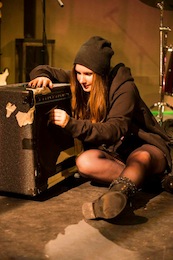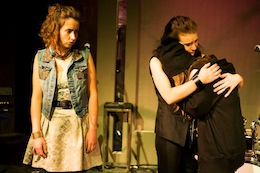Huzzies is simultaneously a relative rarity for theatre-making in Northern Ireland and a revisiting of some well-worn formulae. Its novelty is in the creation of a performance style in which live rock music is both a key focus of the action and a delightful experience in itself. The cast are talented musicians and they give a strong set of performances as the members of Huzzies, a four-piece band trying to break into the music scene. The music for the production has been specially composed by Katie Richardson of cabaret folk rock group Katie and the Carnival. As well as keyboards, drums and guitar, great use is made of kazoos, a telephone and tin mug (and eventually a tambourine) as the story shows the band’s struggle to find their sound. Given just how good their final numbers are, it would have been great to have heard so much more from these performers throughout the show.

The quality of the music is particularly welcome given that so much of the rest of the show follows some well-worn and rather predictable paths: ill-matched individuals come together through music, face some struggles and then achieve some kind of success and, more importantly, self-knowledge. So much so The Commitments, School of Rock and any number of rock biopics. The characters are of course an unlikely combination. Cat Barter’s Claire is a guitar-playing teenage Emo misfit, caught between the demands of her Christian faith and the allure of rock ‘n’ roll. John Shayegh plays twenty-something Pete, the only male member of the group, whose existence outside the band seems sketchy at best. Control of the band is the source of competition between Shona (Doireann McKenna), the stuck-up and privileged girl from the suburbs, and the hard-bitten Dee (Kerri Quinn) for whom the band is the centre of her ambitions to escape the poverty and violence of her working-class background.
While the thinness of the plotting shows through at times – it’s never quite convincing that these people came together and stay together given their differences – Stacey Gregg’s writing shows a keen ear for witty dialogue. The opening section in which the characters narrate the back story from behind the microphones of the band’s rehearsal room is sparky and sharp. This is the setting for the action, although at times the mise-en-scène has to accommodate shifts to other locations, such as the Dee’s bedroom, a venue, and the external of Claire’s church. Niall Rea’s use of lighting achieves these shifts with ease and there is a particularly disturbing use of a back-lit gauze and projection as Dee’s abasement under the pressure of her poverty reaches its nadir in a sleazy hotel bedroom.
 Kerri Quinn’s performance as Dee is superlative: she oozes talent on drums and has a fantastic singing voice. Her characterisation moves Dee beyond cliché, showing a flair for witty one-liners and caustic put-downs, erecting a carapace of street toughness through which her vulnerability and need is still visible. Cat Barter’s Claire is a study in detail, so that even her guitar playing is inflected with the character’s insecurities and ambitions. While John Shayegh’s Pete demonstrates a strong and supportive presence largely in the background, Doireann McKenna has a struggle to give any texture to Shona, a character whose vacuous self-centredness gives the actress little scope.
Kerri Quinn’s performance as Dee is superlative: she oozes talent on drums and has a fantastic singing voice. Her characterisation moves Dee beyond cliché, showing a flair for witty one-liners and caustic put-downs, erecting a carapace of street toughness through which her vulnerability and need is still visible. Cat Barter’s Claire is a study in detail, so that even her guitar playing is inflected with the character’s insecurities and ambitions. While John Shayegh’s Pete demonstrates a strong and supportive presence largely in the background, Doireann McKenna has a struggle to give any texture to Shona, a character whose vacuous self-centredness gives the actress little scope.
The difficulty with any new work is often that it takes a performance in front of an audience before its strengths and weaknesses become apparent. One of the issues for Gregg was to find an ending: will the band triumph over adversity or succumb to the challenges they face? Prompted by knowledge of the form, audience expectations are for the former and the decision to provide an encore where the cast perform as Huzzies is vindicated by an enthusiastic reception. However, the decision to retain the ambiguous downbeat ending to the drama reveals an uncertainty about the narrative arc that should have been resolved before now. A further difficulty is in the focus of the piece where Dee’s is clearly the most developed story-thread but other stories are given some space but not enough to sustain interest. As a consequence, the narrative flags before the interval and the resolutions in the last section are under-motivated.
Yet for all these dramaturgical issues, the performers have charm and talent that provides for a lively and enjoyable night out. This is not a great literary drama but it is a form of theatre that on this showing deserves development and support, provided by young performers who can deliver it with verve and commitment.
Tom Maguire is a Senior Lecturer in Theatre Studies at the University of Ulster.